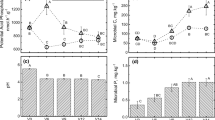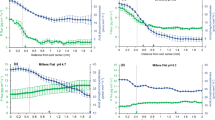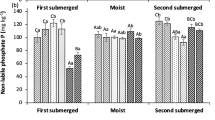Abstract
A new method allowing control of rhizosphere pH and mineral nutrition was applied to study depletion of various organic and inorganic phosphorus fractions extractable sequentially with 0.5M KHCO3 (pH 8.5), 0.1M NaOH and residual P extractable with 6M H2SO4 from the rhizosphere soil.
Soil pH was affected about 2 mm from the root mat. Depletion zones of inorganic P (KHCO3-Pi) extractable with 0.5M KHCO3 extended up to about 4 mm but the depletion zones of all other P fractions were about 1 mm only. The root-induced decrease of soil pH from 6.7 to 5.5 increased the depletion of total P from all fractions by 20% and depletion of KHCO3-Pi and residual P by 34% and 43%, respectively. Depletion of organic P (KHCO3-Po) extractable with 0.5M KHCO3 was not affected by a change in rhizosphere pH. With constant or increased pH, depletion of inorganic P (NaOH-Pi) was 17% and organic P (NaOH-Po) was 22% higher than with decreased pH. Only 54–60% of total P withdrawn from all fractions was from KHCO3-Pi. Substantial amounts of KHCO3-Po and NaOH-Po were mineralized and withdrawn from the rhizosphere within 1 mm from the root mat, as 11–15% of total P withdrawn originated from the organic P fractions. A remaining 11–16% was derived from NaOH-Pi, and 15–18% from residual P fractions likely to be rather immobile. Thus, 40–46% of the P withdrawn near the root mat of rape originated from non-mobile P fractions normally not included in 0.5M NaHCO3 extraction used to obtain an index of plant-available soil P.
Similar content being viewed by others
References
Bagshaw R, Vaidyanathan L V and Nye P H 1972 The supply of nutrient ions by diffusion by plant roots in soil. VI. Effect of onion roots on pH and phosphate desorption characteristics in a sandy soil. Plant and Soil 37, 627–639.
Bekele T, Cino B J, Ehlert P A J, van derMaas A A, vanDiest A 1983 An evaluation of plant borne factors promoting the solubilization of alkaline rock phosphate. Plant and Soil 75, 361–378.
Gahoonia T S and Nielsen N E 1991 A method to study rhizosphere processes in thin soil layers of different proximity to roots. Plant and Soil 135, 143–146.
Gahoonia T S and Nielsen N E 1992 Control of pH at the soil root interface. Plant and Soil 140, 49–54.
Gahoonia T S, Claassen N and Jungk A 1992 Mobilization of phosphate in different soils by ryegrass supplied with ammonium or nitrate. Plant and Soil 140, 241–248.
Grinsted M J, Hedley M J, White R E and Nye P H 1982 Plant induced changes in the rhizosphere of rape seedlings. I. pH change and increase in concentration of soil solution. New Phytol. 91, 19–29.
Harrison A F 1987 Soil organic phosphorus. A Review of World Literature. CAB International, Wallingford, England.
Hedley M J, Nye P H and White R E 1982 Plant induced changes in the rhizosphere of rape (Brassica napus var. Emerald) seedlings. II. Origin of pH change. New Phytol. 91, 31–44.
Hedley M J, Stewart J W B and Chauhan B S 1982a Changes in inorganic and organic soil phosphorus fractions induced by cultivation practices and by laboratory incubations. Soil Sci. Soc. Am. J. 46, 970–976.
Helal H M and Dressler A 1989 Mobilization and turnover of soil phosphorus in the rhizosphere. Z. Pflanzenernaehr. Bodenkd. 152, 175–180.
Hendriks L, Claassen N and Jungk A 1981 Phosphatverarmung des wurzelnahen Bodens und Phosphataufnahme von Mais und Raps. Z. Pflanzenernaehr. Bodenkd. 144, 486–489.
Hoffland E, Findenegg G R and Nelemans J A 1989 Solubilization of rock phosphate by rape. I. Evaluation of the role of uptake pattern. Plant and Soil 113, 155–169.
Lindsay W L and Moreno E C 1960 Phosphate phase equilibrium in soils. Soil Sci. Soc. Am. Proc. 24, 177–182.
Marschner H, Roemheld V, Horst W J and Martin P 1986 Root induced changes in the rhizosphere: Importance for the mineral nutrition of plants. Z. Pflanzenernaehr. Bodenkd. 149, 441–456.
McLaughlin J R, Ryden J C and Syers J K 1977 Development and evaluation of a kinetic model to describe phosphorus sorption by hydrous ferric oxide gels. Geoderma 18, 295–307.
Nielsen N E, Schjørring J K and Jensen H E 1988 Efficiency of fertilizer nitrogen uptake by spring barley. In Nitrogen Efficiency in Agricultural Soils. Eds. D SJenkinson and K ASmith. pp 62–72. Elsevier Applied Science, London and New York.
Ryden J C, McLaughlin J R and Syers J K 1977 Mechanisms of phosphate sorption by soils and hydrous ferric oxide gel. J. Soil. Sci. 28, 72–92.
Tarafdar J C and Jungk A 1987 Phosphatase activity in the rhizosphere and its relation to the depletion of soil organic phosphorus. Biol. Fert. Soils 3, 199–204.
Author information
Authors and Affiliations
Rights and permissions
About this article
Cite this article
Gahoonia, T.S., Nielsen, N.E. The effects of root-induced pH changes on the depletion of inorganic and organic phosphorus in the rhizosphere. Plant Soil 143, 185–191 (1992). https://doi.org/10.1007/BF00007872
Received:
Issue Date:
DOI: https://doi.org/10.1007/BF00007872




